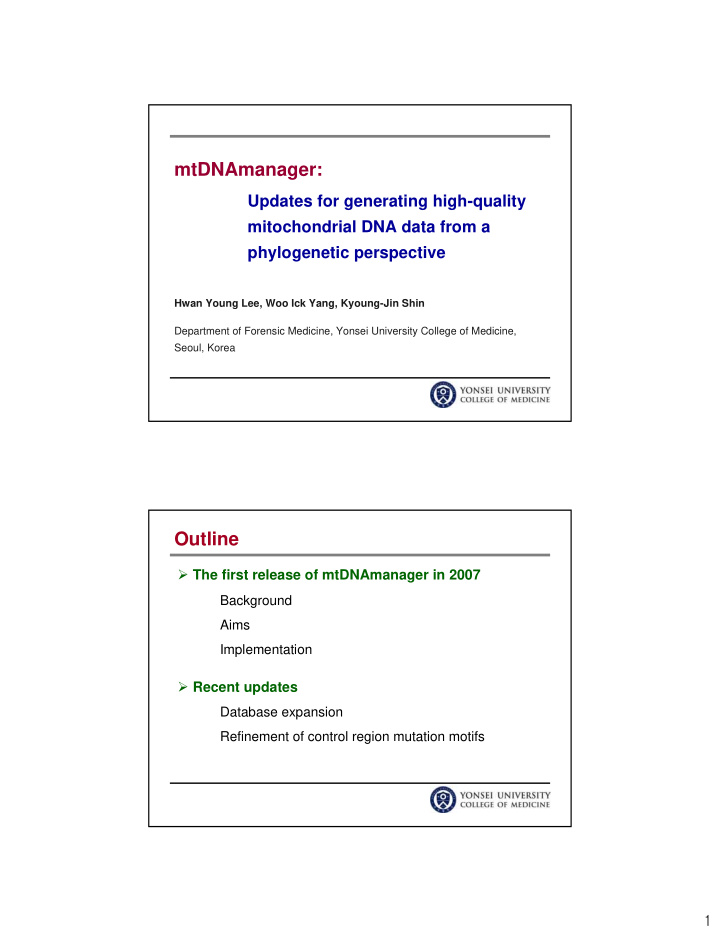



mtDNAmanager: Updates for generating high-quality mitochondrial DNA data from a phylogenetic perspective Hwan Young Lee, Woo Ick Yang, Kyoung-Jin Shin Department of Forensic Medicine, Yonsei University College of Medicine, Seoul, Korea Outline The first release of mtDNAmanager in 2007 Background Aims Implementation Recent updates Database expansion Refinement of control region mutation motifs 1
Background Mitochondrial DNA (mtDNA) typing is more prone to human error than other forensic DNA analysis Errors were mainly due to misinterpretation of sequence raw data and due to the introduction of clerical errors during data transcription Phylogenetic investigations and database screening could have detected prevalent errors in published datasets (e.g., Bandelt et al. Science 2004, 305:1402) How to avoid mtDNA sequence errors Attempts to localize the sequence to a part of phylogeny ( haplogroup ). If the haplogroup motif is not fully represented, recheck the relevant positions in the sequence Have in mind the relative mutability of sites . Be sensitive to rare mutations on different sequence backgrounds in one batch of sequencing Look out for incongruence between parts of the sequences which have been obtained in different PCR or sequencing reactions ( artificial recombinants ) Bandelt et al. IJLM (2001) 115:64-9 2
Need for software development Methodologies based on mtDNA haplogroup determination and comparisons with existing mtDNA haplotypes were proposed for preventing mtDNA errors Manual haplogroup estimation requires a thorough understanding of the worldwide mtDNA phylogeny Database screening for systematic error detection requires high-quality databases that are publicly available mtDNAmanager’s first release in 2007 http://mtmanager.yonsei.ac.kr 3
Worldwide access to mtDNAmanager Since its first release in 2007, the mtDNAmanager has been accessed by users from 75 nations more than 13,000 times Monthly access to mtDNAmanager Number of access Rate of newcomers : Revisit 66.22% Number of visitors 4
Aims of mtDNAmanager To allow researchers to automatically estimate the most- probable mtDNA haplogroups of their mtDNA control region sequences To facilitate database screening with improved query tools To provide researchers with a convenient interface for managing and analyzing their own data in batch mode Design and content of mtDNAmanager The mtDNAmanager interface was designed to allow researchers to easily query the database and immediately view the results on a single page The mtDNAmanager's first release contained 4839 mtDNA control region sequences from FBI and 593 Korean mtDNA control region sequences and a set of bioinformatics tools able to automatically characterize newly submitted data by estimating its most-probable mtDNA haplogroup based on more than 350 haplogroup-specific control region mutation motifs. 5
The most-probable haplogroup estimation The phased designation of haplogroups (i.e. expected haplogroup and estimated haplogroup ) suggests candidate sites that need reinvestigation by allowing the respective confirmation of the presence of clear diagnostic mutations and accompanying mutations. N9a3: 16129-16223-16257A-16261-150 150? 16319 missed out? A5a: 16187-16223-16290-16319-235-523d-524d Database search using query system A query system retrieves sequences that include queried nucleotide polymorphisms from a selected database or the entire population group of its open database. Target database Include setting Estimated mtDNA haplogroup affiliations using the bioinformatics resources of the mtDNAmanager 6
Database search using query system With the alternative setting of match , the mtDNAmanager also searches sequences that match the queried sequence data from the database. Match setting Target database Frequency estimates = (x+2)/(n+2) A sample system 7
A match system A query system 8
Updates from the first release The number of mtDNA control region sequences in the mtDNAmanager’s open database has grown from 5,432 to 9,180 , while the number of population groups has been increased to more than 20. The number of control region mutation motifs for the assignment of the most-probable mtDNA haplogroups has grown from 350 to more than 590 . 9
mtDNAmanager’s current open database 20 more publications were added Expansion of mtDNAmanager’s database DB at 1 st release Current DB 10
Improved database search Recent updates in phylogenetic trees PhyloTree.org South East Asian: ~M71, M72 South Asian: M31, M33, M51… African: L0~L5 11
Control Region Mutation motif for more than 590 mtDNA haplogroups Improved mtDNA haplogroup estimation Refinement of mtDNA phylogeny with more diagnostic mutations would facilitate the detection of more errors in mtDNA sequence since it is based on mutation motifs Added mutation motifs enables refined mtDNA haplogroup estimation 12
Updates in mtDNAmanager Refinement of mtDNA phylogeny with more diagnostic mutations would provide better algorithms for automatic estimation of the most-probable mtDNA haplogroups in diverse population groups, and facilitate the detection of more errors in mtDNA sequence data by suggesting more candidate sites for reinvestigation A neighbourhood search for sequences in the expanded open database would facilitate pinpointing errors through extensive data comparison using the expanded subset of the total database 13
Concluding remarks With these improvements mtDNAmanager will help in checking the quality of data and facilitate data comparisons from a phylogenetic perspective Continuous efforts are needed to collect and integrate high-quality mtDNA control region sequence data for various population groups in South East Asia and Oceania For comments, bug reports, suggestions for improvement, please contact us through the website (http://mtmanager.yonsei.ac.kr). 14
More recommend